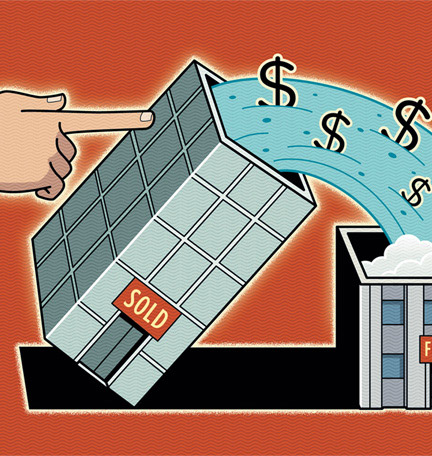A campaign to build up an endowment fund can produce more consistent — and potentially limitless — income for your non-profit organization.
It’s easy for your staff and volunteers to get wrapped up in the excitement of fundraising events such as runs, walks, rides, dinners, dances, auctions, or golf outings. Such events generate welcome publicity for your cause and the income your nonprofit needs to fund key programs, keep the lights on, and compensate its valued employees.
But as times change, expenses rise, competing fundraising events proliferate, and enthusiasm for older, legacy events wanes, it may be a good time to step back and consider another potential source of income for your organization: Endowments. A campaign to build up an endowment fund can produce more consistent — and potentially limitless — income for your organization’s needs.
Focus on Inflows vs. Investments
It’s not uncommon for the income generated by endowments to be a significant source of funding for established nonprofits. Even with endowment support, Harvard must fund nearly two-thirds of its operating expenses ($5.0 billion in fiscal year 2018) from other sources, such as federal and non-federal research grants, student tuition and fees, and gifts from alumni, parents, and friends.1
Steady and predictable endowment income can help your organization keep up with ongoing expenses and support future growth. “It also relieves the pressure to be constantly fundraising,” says Marcie Braswell, Philanthropic Solutions Executive at Regions Bank.
There are two primary ways to grow endowment income.2 The first is to increase an endowment’s investment returns while reducing expenses. Still, that route may be limited by the risk guidelines of your investment policy statement (IPS) and the vicissitudes of financial markets.
The other way is to increase the inflow of gifts into the endowment by focusing on three key areas: communications, education, and donor relations. If done well, your efforts can produce a dramatic increase in your organization’s annual income.
Three Key Ways to Increase Giving
You already know the best prospects for increasing donations are the generous individuals and businesses who give to your organization on a regular basis. They believe in your mission and support your work, so it makes sense to encourage them to take their giving in a new direction — or to a new level.
“Look for donors with consistent giving over five to ten years. Think about the individuals and businesses who already support you and who want to see you thrive and continue. Perhaps one of them might be willing to be a lead gift on a new endowment that supports a particular position in your organization,” Braswell suggests.
Communications: Start by telling your story
Once you’ve settled on the group of donors you plan to approach, take a look at the message you want to send them. “As they begin raising more money for their endowments, one of the biggest challenges we’ve seen nonprofits face is in defining their vision and articulating it consistently to their donors,” says Braswell.
“Make sure you’re able to tell your story so that potential donors can envision what the future of your nonprofit can look like with their help,” she stresses. “Paint a picture of how their help can be transformative to your nonprofit and the community.”
“Your story needs to show donors and prospects the impact that their donations will have on your organization’s future success, and that can be challenging,” echoes Jennifer Foster, Vice President and Philanthropic Solutions Advisor at Regions Bank. Once you’re ready with your story, you can use all your regular communication channels to tell it: Monthly newsletters, emails, and social media posts. Perhaps you’ll also use seminars and webinars that feature experts from your nonprofit’s ranks.
Remember that a phone call from one of your board members may be the best communication technique for a high potential donor.
Education: Introduce more giving possibilities
In addition to telling your story — the “why” behind your endowment fundraising — you’ll want to outline the “how” by educating potential donors about your nonprofit’s existing funds and the thresholds they can meet to make more significant, lasting gifts.
Offering several levels of giving also “feeds into donors’ competitive nature,” says Kevin V. Phillips, Philanthropic Solutions Area Manager in Birmingham at Regions Bank. “Having tiered levels of giving can be particularly enticing because some donors end up being pretty competitive. They see somebody else’s name in a higher group and they want to be there too. It encourages them to give even more.”
It’s also possible that donors who have been supporting your organization for a number of years haven’t considered other ways of giving that could have greater impact. For a few hundred dollars more, for example, a long-time donor might be ready to make a larger contribution to an endowment that supports a specific scholarship fund or staff position — and get recognized for his or her generosity.
High-level donors may be willing to help create new endowments with “lead gifts” funded today or through contributions over time. Knowing they can name the endowment as they wish can be a tremendous motivator.
For a donor who isn’t ready to make a long-term commitment to an endowment right now, don’t forget to introduce other planned giving strategies that can create an ongoing legacy in the future — and may also reduce taxes today. “I like to think of this as having many different arrows in your quiver to grow you donor base,” says Phillips.
Depending on your organization’s gift acceptance policy, your “quiver” of giving strategies for donors could include any of the following:
- Establishing a Charitable Lead or Charitable Remainder Trust
- Donating an unneeded Required Minimum Distribution (RMD) from a retirement account
- Designating life insurance proceeds
- Earmarking bequests for a particular endowment
- Giving highly appreciated securities
- Contributing land or real estate assets
- Contributing to a Pooled Income Fund
Donor Relations: Remind them how their gifts assure your success
All donors want to know that their gifts make a difference. Some donors will even “test the waters” and delay further contributions until they feel comfortable that a nonprofit is using their funds wisely and appropriately. Larger donors will often enlist the help of their financial advisors or philanthropy consultants to objectively evaluate the effectiveness of their gifts.
Donors who give to endowments are no different. “It’s not unusual to see a large donor ‘testing’ to see if a nonprofit is going to be a good steward of their money and to see how the organization tries to build a relationship in order to get a larger gift later,” says Phillips. That’s why nurturing key donors is something Phillips and his team highly recommend. “It could be as simple as having board members call donors to thank them and have a conversation about why they gave.”
Depending on the size of their gifts, some donors may enjoy being invited to special events, appreciation luncheons, or on-site tours. Or they may want to meet with some of the people they have helped, key people in your organization, or members of your board. Immediate and special recognition of the donors who help grow your endowments is essential.
“You can get quite specific in targeting special donors too,” says Phillips. For example, one of Phillips’s non-profit clients recently held a luncheon to recognize the people who left money for the organization in their wills. “They wanted to acknowledge the donors during their lifetimes, even though their gifts won’t be available until many years in the future,” he explains.
How Regions can help you meet your fundraising challenges
For many decades, Regions Bank has helped non-profit organizations successfully overcome their endowment, foundation, planned giving, and investment management challenges. Our extensive experience with nonprofits means we are able to offer every client:
- Specialized assistance with setting up and managing foundations and endowments
- Practical knowledge about the best practices for nonprofit financial management and governance
- A full array of products, services, and solutions for planned giving
- The support of a dedicated, experienced planned giving officer to help manage the impact of different types of gifts (such as land, complex assets, private business interests)
Connect with our team to determine how Regions can help guide your organization’s investment needs.
1https://www.harvard.edu/about-harvard/harvard-glance/endowment
2Commonfund Institute, Strategies for Increasing Endowment Giving at Colleges and Universities, September 2007











